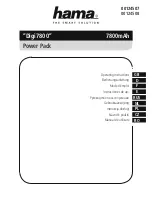
1. Secure the workpiece to the Table.
2. Mark the desired hole depth on the side
of the workpiece.
Also view the depth indicator on the Depth
Stop Ring (37).
3. Loosen the Depth Lock Screw (38).
4. Turn the scale on the Depth Stop Ring
to the desired depth and retighten the
Depth Lock Screw.
5. Turn the Drill Press ON and pull the
Feed Knob (34) counterclockwise until it
drills the hole and stops at the set depth.
6. Turn the Drill Press OFF.
The Drill Press has five different Chuck
speeds. Refer to the speed chart in the
Belt Guard (A25).
1. Lift the Belt Guard lid.
2. Loosen the Thumb Nut (28). The belt
tension should release.
3. Move the V-belt (A1) to the desired le-
vel (speed) on the pulleys.
4. Push the Motor (22) backward and hold.
Retighten the Thumb Nut.
Note:
To test the proper belt tension, push
in on the center of each belt at its center.
It should move only 1/2 inch (in or out).
5. Close the Belt Guard Lid.
ADJUSTING THE TABLE
CHANGING THE CHUCK SPEED
SETTING THE DEPTH SCALE TO DRILL
TO A SPECIFIED DEPTH
ADJUSTING THE FEED WHEEL
RETURN TENSION SPRING
REMOVING THE CHUCK AND
SPINDLE SHAFT
INSTALLING THE CHUCK AND
SPINDLE SHAFT
Warning: Before performing any
maintenance to this machine, remove
the line cord from the electrical out-
let.
During this procedure, refer to the Chuck
and Spindle Assembly Drawing.
1. Pull the Feed Knob counterclockwise
and hold the Chuck at a depth of three
inches.
2. Align the key holes in the Spindle (A15)
shaft and the Quill Tube (A10) by turning
the Chuck by hand.
3. Insert a Wedge Drift Key (not supplied)
into the key holes.
4. Lightly tap the wedge Drift Key (A14)
with a rubber mallet until the Spindle shaft
falls out of the Quill Tube.
Place a bundled cloth or basket below the
Chuck to catch it when it falls.
1. Using a clean cloth, wipe the tapered
surfaces on the Spindle shaft (A15).
2. Slide the Spindle shaft and Chuck as-
sembly up and into the Quill Tube (A10).
At the same time, turn the assembly until
the rectangular end of the Spindle shaft
slips into the notch on the Quill Tube.
Warning: In the previous step, if the Spind-
le shaft is not properly set in the Quill Tube
notch, it may fly out during operation.
3. Loosen the Support Clamp (B16) and
raise the Table (B20) about three inches
below the Chuck.
4. Turn the Chuck sleeve clockwise to open
the jaws completely.
5. Pull the Feed Knob counterclockwise
and force the Chuck against the Table un-
til the Spindle shaft is secure.
Caution: Wear a full face shield du-
ring this procedure.
1. Move the Chuck to its uppermost posi-
tion and lock in place.
2. Insert a screwdriver in the lower-front
notch of the Cap Spring (8).
Hold it in place and, using a wrench, re-
move the (outer) Hex Nut (7) only.
3. With the screwdriver still in place, loo-
sen the (inner) Hex Nut (7) until the Cap
Spring notch disengages from the Spring
Retainer (10) -- about 1/8 inch.
4. Turn the screwdriver counterclockwise
1. Loosen the Support Clamp (B16).
2. Turn the Crank (B8) to move the Table
to the desired height.
3. Tighten the Support Clamp.
4. To tilt the Table, loosen Hex Bolt (B12)
and turn the Table. The scale can be used
to approximate the angle. Tighten the Hex
Bolt.
Summary of Contents for SB 3116RHN
Page 3: ...1 2 3 4 5 7 8 6 9 10 11 12 13 14 15 Abb 1 1 Fig 1 1 SB 3116RHN...
Page 4: ...www holzmann maschinen at 1 2 3 4 5 7 8 6 9 10 11 12 13 14 Abb 1 2 Fig 1 2 SB 3116RMN...
Page 27: ...6 WIRING DIAGRAM SCHALTDIAGRAMM SB 3116RHN SB 3116RMN...
Page 28: ...www holzmann maschinen at 7 SPARE PARTS ERSATZTEILE Abb 2 Fig 2 SB 3116RHN SB 3116RMN...
Page 29: ...Abb 3 Fig 3 SB 3116RHN SB 3116RMN...
Page 30: ...www holzmann maschinen at Abb 4 1 Fig 4 1 SB 3116RHN...














































